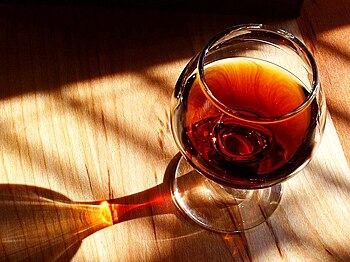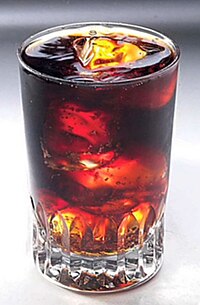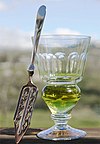The Drink Portal
A portal dedicated to all beverages
Introduction

A drink or beverage is a liquid intended for human consumption. In addition to their basic function of satisfying thirst, drinks play important roles in human culture. Common types of drinks include plain drinking water, milk, juice, smoothies and soft drinks. Traditionally warm beverages include coffee, tea, and hot chocolate. Caffeinated drinks that contain the stimulant caffeine have a long history.
In addition, alcoholic drinks such as wine, beer, and liquor, which contain the drug ethanol, have been part of human culture for more than 8,000 years. Non-alcoholic drinks often signify drinks that would normally contain alcohol, such as beer, wine and cocktails, but are made with a sufficiently low concentration of alcohol by volume. The category includes drinks that have undergone an alcohol removal process such as non-alcoholic beers and de-alcoholized wines. (Full article...)
Selected article -
In cool climates (such as many German wine regions), Riesling wines tend to exhibit apple and tree fruit notes with noticeable levels of acidity that are sometimes balanced with residual sugar. A late-ripening variety that can develop more citrus and peach notes is grown in warmer climates (such as Alsace and parts of Austria). In Australia, Riesling is often noted for a characteristic lime note that tends to emerge in examples from the Clare Valley and Eden Valley in South Australia. Riesling's naturally high acidity and pronounced fruit flavors give wines made from the grape exceptional aging potential, with well-made examples from favorable vintages often developing smokey, honey notes, and aged German Rieslings, in particular, taking on a "petrol" character.
In 2015, Riesling was the most grown variety in Germany with 23.0% and 23,596 hectares (58,310 acres), and in the French region of Alsace with 21.9% and 3,350 hectares (8,300 acres). In Germany, the variety is particularly widely planted in the Mosel, Rheingau, Nahe and Pfalz wine regions. There are also significant plantings of Riesling in Austria, Slovenia, Serbia, Czech Republic, Slovakia, Luxembourg, northern Italy, Australia, New Zealand, Canada, South Africa, China, Crimea, and the United States (Washington, California, Michigan, and New York). (Full article...)
Did you know? -
- ... that The Drunkard's Progress suggests that a single social drink leads to poverty, crime, and suicide?
- ... that Ben Phillips replaced his friend's hair gel with superglue, put Viagra in his sports drink, and placed him on a lake while he slept on an inflatable mattress?
- ... that salt marsh snakes drink only rainwater?
- ... that Al-Rantisi Hospital can extract drinking water from air?
- ... that in 1776 Abraham Hunt entertained Hessian mercenaries with food and drink to render them incapable for duty the night before George Washington defeated them at Trenton?
- ... that Assyrian Christian couples drink dust from the tombs of martyrs and are crowned during their weddings?
General images -
Selected image -

Selected biography -
The Bronfman family is a Canadian family, known for its extensive business holdings. It owes its initial fame to Samuel Bronfman (1889–1971), the most influential Canadian Jew of the mid-20th century, who made a fortune in the alcoholic distilled beverage business during American prohibition, including the sale of liquor through organized crime, through founding the Seagram Company, and who later became president of the Canadian Jewish Congress (1939–62).
The family is of Russian-Jewish and Romanian-Jewish ancestry; the patriarch, Yechiel (Ekiel) Bronfman, was originally a tobacco farmer from Bessarabia. According to The New York Times staff reporter Nathaniel Popper, the Bronfman family is "perhaps the single largest force in the Jewish charitable world". (Full article...)Selected quote -
| “ | The bar is in full swing, and floating rounds of cocktails permeate the garden outside, until the air is alive with chatter and laughter, and casual innuendo and introductions forgotten on the spot, and enthusiastic meetings between women who never knew each other’s names. | ” |
| — F. Scott Fitzgerald The Great Gatsby (1925) |
Selected ingredient -

Caramel color or caramel coloring is a water-soluble food coloring. It is made by heat treatment of carbohydrates (sugars), in general in the presence of acids, alkalis, or salts, in a process called caramelization. It is more fully oxidized than caramel candy, and has an odor of burnt sugar and a somewhat bitter taste. Its color ranges from pale yellow to amber to dark brown.
Caramel color is one of the oldest and most used food colorings for enhancing naturally occurring colors, correcting natural variations in color, and replacing color that is lost to light degradation during food processing and storage. The use of caramel color as a food additive in the brewing industry in the 19th century is the first recorded instance of it being manufactured and used on a wide scale. Caramel color is found in many commercially made foods and beverages, including batters, beer, brown bread, buns, chocolate, cookies, cough drops, spirits and liquor such as brandy, rum, and whisky, chocolate-flavored confectionery and coatings, custards, decorations, fillings and toppings, potato chips, dessert mixes, doughnuts, fish and shellfish spreads, frozen desserts, fruit preserves, glucose tablets, gravy, ice cream, pickles, sauces and dressings, soft drinks (especially colas), sweets, vinegar, and more. Caramel color is widely approved for use in food globally but application and use level restrictions vary by country. (Full article...)
Topics
| General topics: | Bartending • Bottling • Drinking • Drinking water • Bottled water • Mineral water • Coffee • Energy drink • Juice • Tea • Milk • Plant milk • Pasteurization • Refrigeration • Steeping • Water purification |
| Alcoholic beverages: | Beer • Brandy • Brewing • Caffeinated alcoholic drinks • Cider • Cocktails • Distillation • Fermentation • Hard soda • Liquor • Liqueur • Malt drink • Mead • Proof • Rice Wine • Schnapps • Vodka • Whiskey • Wine |
| Soft Drinks: | Carbonation • Cola • Orange soft drink • Frozen carbonated drink • Root beer • Soda water • Lithia water • |
| Miscellaneous: | Drink industry • Lemonade • Limeade • Orange drink • Slush (beverage) |
List articles
Subcategories
Related portals
WikiProjects


WikiProject Food & Drink is an association of Wikipedians with an interest in culinary-related subjects. They have come together to co-ordinate the development of food and drink articles here on Wikipedia as well as the many subjects related to food such as foodservice, catering and restaurants. If you wish to learn more about these subjects as well as get involved, please visit the project.
 WikiProject Beer – covers Wikipedia's coverage of beer and breweries and microbreweries
WikiProject Beer – covers Wikipedia's coverage of beer and breweries and microbreweries
![]() WikiProject Wine – aims to compile thorough and accurate information on different vineyards, wineries and varieties of wines, including but not limited to their qualities, origins, and uses.
WikiProject Wine – aims to compile thorough and accurate information on different vineyards, wineries and varieties of wines, including but not limited to their qualities, origins, and uses.
| Child projects: | Task forces: (All inactive) |
| Related projects: | |
Things you can do
 |
Here are some tasks awaiting attention:
|
Associated Wikimedia
The following Wikimedia Foundation sister projects provide more on this subject:
-
Commons
Free media repository -
Wikibooks
Free textbooks and manuals -
Wikidata
Free knowledge base -
Wikinews
Free-content news -
Wikiquote
Collection of quotations -
Wikisource
Free-content library -
Wikiversity
Free learning tools -
Wiktionary
Dictionary and thesaurus




































































